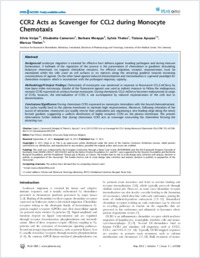CCR2 acts as scavenger for CCL2 during monocyte chemotaxis
- Volpe, Silvia Institute for Research in Biomedicine (IRB), Faculty of Biomedical Sciences, Università della Svizzera italiana, Switzerland
- Cameroni, Elisabetta Institute for Research in Biomedicine (IRB), Faculty of Biomedical Sciences, Università della Svizzera italiana, Switzerland
- Moepps, Barbara Institute of Pharmacology and Toxicology, University of Ulm Medical Center, Ulm, Germany
- Thelen, Sylvia Institute for Research in Biomedicine (IRB), Faculty of Biomedical Sciences, Università della Svizzera italiana, Switzerland
- Apuzzo, Tiziana Institute for Research in Biomedicine (IRB), Faculty of Biomedical Sciences, Università della Svizzera italiana, Switzerland
- Thelen, Marcus Institute for Research in Biomedicine (IRB), Faculty of Biomedical Sciences, Università della Svizzera italiana, Switzerland
-
17.05.2012
Published in:
- Plos one. - 2012, vol. 7, no. 5, p. e37208
English
Background: Leukocyte migration is essential for effective host defense against invading pathogens and during immune homeostasis. A hallmark of the regulation of this process is the presentation of chemokines in gradients stimulating leukocyte chemotaxis via cognate chemokine receptors. For efficient migration, receptor responsiveness must be maintained whilst the cells crawl on cell surfaces or on matrices along the attracting gradient towards increasing concentrations of agonist. On the other hand agonist-induced desensitization and internalization is a general paradigm for chemokine receptors which is inconsistent with the prolonged migratory capacity. Methodology/Principal Findings: Chemotaxis of monocytes was monitored in response to fluorescent CCL2-mCherry by time-lapse video microscopy. Uptake of the fluorescent agonist was used as indirect measure to follow the endogenous receptor CCR2 expressed on primary human monocytes. During chemotaxis CCL2-mCherry becomes endocytosed as cargo of CCR2, however, the internalization of CCR2 is not accompanied by reduced responsiveness of the cells due to desensitization. Conclusions/Significance: During chemotaxis CCR2 expressed on monocytes internalizes with the bound chemoattractant, but cycles rapidly back to the plasma membrane to maintain high responsiveness. Moreover, following relocation of the source of attractant, monocytes can rapidly reverse their polarization axis organizing a new leading edge along the newly formed gradient, suggesting a uniform distribution of highly receptive CCR2 on the plasma membrane. The present observations further indicate that during chemotaxis CCR2 acts as scavenger consuming the chemokine forming the attracting cue.
- Language
-
- English
- Classification
- Medicine
- License
- Open access status
- gold
- Identifiers
-
- RERO DOC 326691
- DOI 10.1371/journal.pone.0037208
- ARK ark:/12658/srd1319127
- Persistent URL
- https://n2t.net/ark:/12658/srd1319127
Statistics
Document views: 165
File downloads:
- Texte intégral: 192
